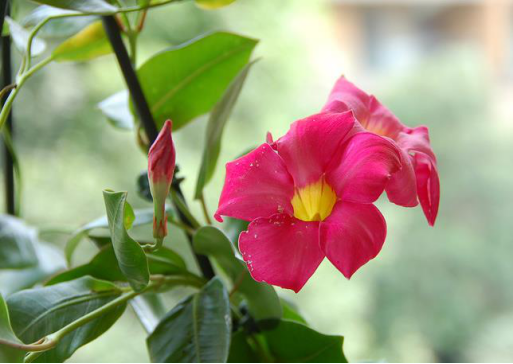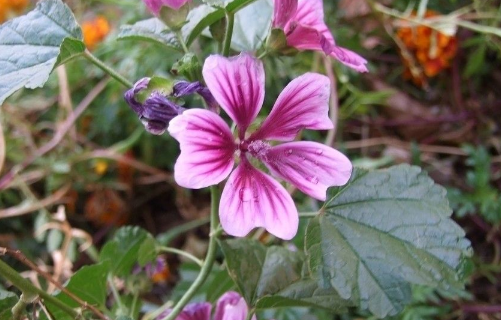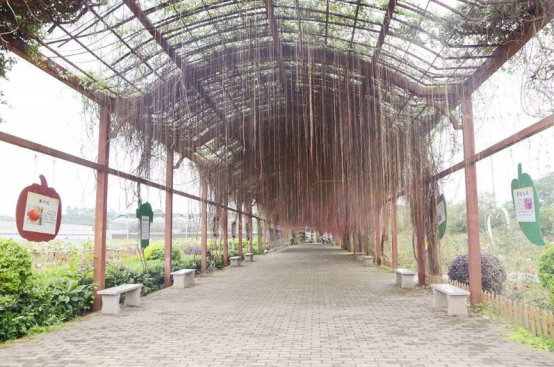Culture method of Tripterygium wilfordii
1. Light and temperature
As a tropical plant, the fragrant vine likes the warm and sunny environment, the suitable temperature for growth is generally 25 ℃, the vine is not hardy, and its growth will be inhibited in winter, so it is necessary to move the vine into the sunny room or greenhouse to keep the temperature above 10 ℃ to survive the winter safely.
two。 Moisture content
Due to the sunny growth of fragrant vines, more watering is added in summer to keep the soil moist. Need to reduce watering in winter, so that the fragrant vine into the dormant period to survive the winter smoothly. Outdoor cultivation should not be planted in too low-lying places, so as to avoid stagnant water in the soil, lack of oxygen or soaking roots.

3. Cultivation substrate
Tripterygium wilfordii has strong adaptability to soil, and the substrate rich in nutrients and humus is the best. If used for indoor potted plants, a small amount of coarse sand and rotten leaf soil can be used in the north, and pond mud, peat soil and river sand can be used in the south, which can be mixed at 5:3:2 to form the base soil.
4. Fertilizer application
During the growing period, an appropriate amount of compound fertilizer can be applied, a small amount of topdressing for many times, so as to avoid excessive vegetative growth and affect flowering. Balanced slow-release fertilizer can be applied in pot soil, and compound fertilizer with balanced ratio of nitrogen, phosphorus and potassium is generally applied in spring, twice a week, about 150ppm each time. In summer, in order to promote the smooth flowering of Tripterygium wilfordii, fertilizer with high phosphorus content of 150ppm can be added appropriately.
5. Pest control
The disease is mainly caused by Cercospora leaf spot and leaf blight and other leaf diseases, the disease can be controlled by mancozeb and other agents, appropriate dripping solution, do not treat violently. Select the matrix with good drainage, keep the soil dry and wet alternately, and put the fragrant vine in a place with sufficient light to ensure ventilation, which can effectively prevent the occurrence of root rot.
6. Pruning and transplanting
The purpose of pruning is for shaping, the vine can be pruned after flowering, if it is a newly planted plant, it can only be cut lightly, and the old perennial plant can be cut in spring to promote the germination of strong new branches. Occasional pruning will help the vine to maintain a suitable growth shape and help the vine plant to be fuller and blossom more beautiful.
The culture method of how to raise Piaoxiang vine
The fragrant vine is a vine of the family Apocynaceae, the stem is soft and flexible, spiraling up along the bracket, the pink trumpet-like flowers are big and straight, how to raise the fragrant vine? Let's take a look at the culture method of Piaoxiang vine.
First, the culture method of Piaoxiang vine
1. Soil: Tripterygium wilfordii has strong adaptability to soil, basin soil needs good drainage, and the matrix with modifier and humus is the best. Indoor pot cultivation in the north can use rotten leaf soil with a small amount of coarse sand, the south can use pond mud, peat soil, river sand mixed at 5:3:2.
2.Illumination: the optimum intensity of Liriodendron fragrans is 10000-20000Lux.
3. Temperature: Piaoxiang is not cold-resistant, the suitable temperature for growth is 20 ℃ ~ 30 ℃, and the growth is inhibited when the outdoor temperature is lower than 7.5 ℃. The Beijing area should stay indoors against the cold and spend the winter. when overwintering, the leaves may fall and blossom again in spring.
4. Humidity: the dry soil of Tripterygium wilfordii planting affects fertilizer absorption, and too wet will cause root death or other diseases. Especially in winter, it is necessary to reduce watering and keep the soil dry.
5. Watering: increase watering of fragrant vines in summer to avoid completely dry soil. Outdoor cultivation should not be planted in too low-lying places, so as not to cause hypoxia and poor growth caused by stagnant water. Humidity the optimum air relative humidity is 70-80%, which should be less than 50%.
6. Fertilization: Tripterygium wilfordii needs reasonable fertilization during the vigorous growth period in spring and summer. Balanced slow-release fertilizer can be applied in basin soil, and then liquid fertilizer can be applied every 7 ~ 10 days. Generally, compound fertilizers with a balanced proportion of nitrogen, phosphorus and potassium are applied in spring, such as 15-15-15, twice a week, about 150ppm each time; in late spring or early summer, 150ppm fertilizers with high phosphorus content, such as 10-20-10, can be added to promote plant flowering.
7. Pruning: Tripterygium can be pruned after transplanting. If it is an one-or two-year-old plant, it can be trimmed lightly, mainly for plastic surgery. Old perennial plants can be forcefully cut in spring to promote the germination of strong new branches.
8. pest control: the diseases of Piaoxiang rattan are mainly leaf diseases such as leaf spot and leaf blight caused by Cercospora, and root rot and stem rot caused by Fusarium. Carbendazim and mancozeb can be used to control the disease at the initial stage. Red spider and whitefly are the most harmful pests, which can be controlled by imidacloprid and so on.
The above is the introduction of fragrant rattan culture methods, fragrant rattan flowers are colorful, very suitable for indoor potted plants, to add a trace of fresh breath to the home.
Culture methods and points for attention of Tripterygium wilfordii
Culture method of Tripterygium wilfordii
Lighting requirements: fragrant vines like warm, humid and sunny environment, there is sufficient light to ensure the normal growth of fragrant vines, half-day to full-day sunshine. Of course, fragrant vines can also be maintained in a slightly shaded place.
Water and fertilizer management: water and fertilizer management should be done well in the maintenance process of Piaoxiang vine. In watering, it is necessary to control watering, do not be too waterlogged and dry, so that the plant growth is poor. Do a good job in water and fertilizer management, can form a developed root system, the growth of fragrant vine will be exuberant. During the growing period, an appropriate amount of compound fertilizer can be applied for 5 times.
Temperature requirements: the best temperature for the growth of Piaoxiang vine is between 20 ℃ and 30 ℃, and it is best not to exceed 35 ℃. It is easy to frostbite when the temperature is too low in winter, so pay attention to keep the temperature in winter, preferably not less than 10 ℃.
Soil selection: Piaoxiang vine has low requirements for soil and strong adaptability, but it is better to use sandy loam rich in humus and good drainage.
Propagation method: Tripterygium wilfordii is generally propagated by cutting, and can also be propagated rapidly by tissue culture.
Pruning: the pruning of fragrant vines usually takes two times. Pruning after flowering and pruning in spring. Pruning after flowering can be trimmed for fragrant rattan to make it beautiful. Pruning old plants in spring can promote the germination of new branches.
Matters needing attention in culture of Tripterygium wilfordii
The light should be sufficient, and the lack of light will lead to the reduction of the flowering of the fragrant vine.
The application amount of nitrogen fertilizer should be controlled when fertilizing, so as to prevent the plant of Piaoxiang vine from affecting flowering and reducing flowering due to its high nutrition and over-prosperous growth.
Although Tripterygium wilfordii has strong stress resistance and is less infected with diseases, we should also pay attention to preventive measures.
- Prev

Culture methods of mallow
Soil mallow does not have very high requirements for soil. We can use slightly acidic rotten leaf soil or nutritious soil, and sandy soil is also OK. When we transplant mallow into a flowerpot, we should first put it in a position that can accept the sun and let it stay in the sun for half a day, which will be beneficial to the later flowering of the plant.
- Next

Culture method of Tripterygium paniculata in winter
one。 To provide a suitable environment Jinping vine loves the sun very much, is resistant to drought and high temperature, and is easy to cultivate. Its growth is relatively slow, and the suitable temperature is about 22-30 ℃. If the average air bearing in winter is less than 10 ℃, it is necessary to prevent the cold to help the air root grow and water it every two or three days.
Related
- Fuxing push coffee new agricultural production and marketing class: lack of small-scale processing plants
- Jujube rice field leisure farm deep ploughing Yilan for five years to create a space for organic food and play
- Nongyu Farm-A trial of organic papaya for brave women with advanced technology
- Four points for attention in the prevention and control of diseases and insect pests of edible fungi
- How to add nutrient solution to Edible Fungi
- Is there any good way to control edible fungus mites?
- Open Inoculation Technology of Edible Fungi
- Is there any clever way to use fertilizer for edible fungus in winter?
- What agents are used to kill the pathogens of edible fungi in the mushroom shed?
- Rapid drying of Edible Fungi

